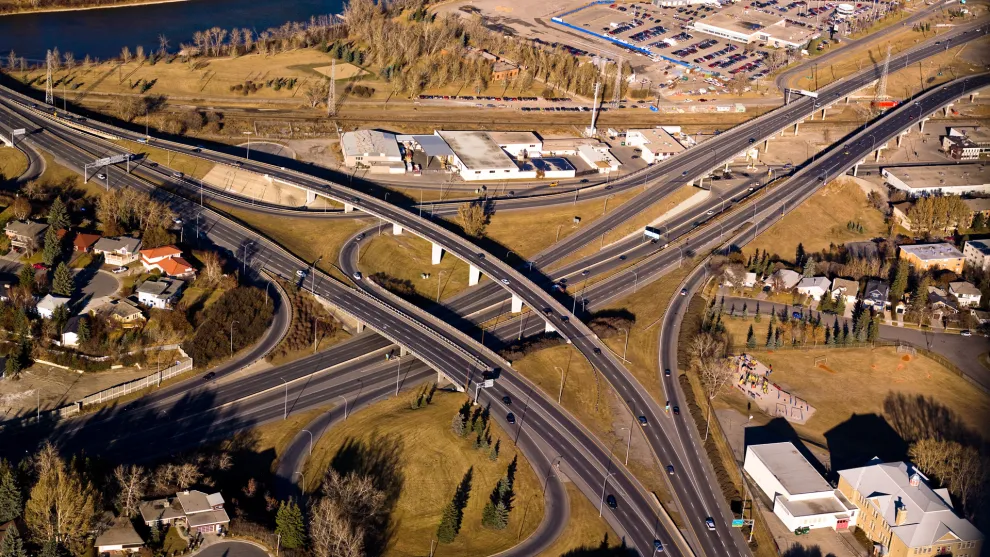Calgary West LRT – Setting the Foundation for Better Accessibility
Are you looking for similar expertise for your project?
Lafarge Canada was a design-build contractor for the Calgary West LRT Project, the largest infrastructure project the City of Calgary had ever initiated. Calgary’s entire LRT system transports about 300,000 passengers daily, making it the most-travelled LRT system in North America. Lafarge is proud to have been involved in such a massive and crucial project.
Lafarge’s role in the project was valued at $48 M and involved:
- Construction of surface works, including roadway construction, curbs, and gutters
- Fabrication and installation of precast arches
- Design and development of station infrastructure for the project
This was a unique opportunity for the company because it required the team to utilize all seven product lines to accomplish its extensive role.
THE CHALLENGE
The Calgary West LRT line consists of 7.7 km of new track starting downtown at 7 Ave. and 10 Street, running west to 69 Street and 17 Ave. in Strathcona Park. The project features six new stations, including the first elevated and underground stations in Calgary's LRT system.
At the time, the $1.4 billion West LRT project was the largest infrastructure project the City of Calgary had ever taken on. This integrated transportation system includes a new LRT line, reconfigured bus routes to accommodate the new stations, expanded and improved walking and biking trails, and an enhanced highway/road network. These improvements and new developments connect Calgarians travelling to and from the city's west end to the rest of Calgary.
Lafarge supplied concrete for the tunnels, bridges, and other structural concrete needed to build the new LRT system. The company’s Precast division had worked on several LRT stations, so the team was experienced in the general requirements around such parts of the job.
Therefore, Lafarge also provided components for the new stations and leveraged its knowledge to achieve the best results within project deadlines.
Furthermore, Lafarge Pipe provided the pipe and maintenance hole systems required for a new deep utility system, taking into account Calgary’s unique weather patterns to minimize adverse impact during extreme conditions.
Aside from planning for the technical needs, Lafarge also took on a few challenges unique to this project.
At the West LRT project, Lafarge Construction was responsible for constructing surface works, which included reconstructing roadways and construction detours and providing all the aggregates, asphalt, concrete curbs, gutters, and barriers needed along the 7.7 km route.
Execution of the surface works in a safe, efficient, and expedient manner was essential to the success of the project. Hence, the team needed to keep the traffic flowing to complete the construction of tunnels, utilities, and stations. This posed a huge logistical challenge as the West LRT followed a tight timeline.
Lafarge was working with several other contractors on this project, so it was critical to follow a detailed scheduling plan to prevent delays. Establishing an effective schedule required collaborating and communicating with other contractors and stakeholders working on the project.


THE SOLUTION
The multi-faceted solution from Lafarge involved arranging products for the project and creating an optimal supply chain to transport them to the construction location. The project team was detail-oriented during the planning process because the use of 7 different product lines meant the company was able to exhibit several layers of expertise.
To prepare for this level of streamlined execution, our group spent four months studying the details of the West LRT project, including set-up and how to proceed with the work to ensure project success.
As part of this preparation, Lafarge’s precast and pipe teams conducted thorough inspection processes on their components at the plants, the largest facilities of their kind in Western Canada. This decision allowed our quality control team to inspect the precast concrete production process thoroughly to ensure that our utility trenches were produced according to the specific engineered drawings.
As a requirement of its CPCI certification, Lafarge tests all concrete utilized in precast concrete production before pouring to ensure it meets the project criteria. Similarly, prior to stripping and shipping, the team tested the cylinders taken during the pre-pour testing process to ensure they met the appropriate level of strength.
Given the company's extensive experience in collaborative scheduling, the team was confident in its ability to carry out its responsibilities. The project managers worked with the other contractors to develop plans, allowing everyone to maximize efficiency.
The teams were accustomed to establishing connections, which helped them create a seamless coordination system to achieve their goals.
Lafarge’s contribution provided several strategic benefits to this project. Aside from being the one-stop provider of diverse materials required for such a complex project, the team also had the ability to supply the skilled labour force and equipment to get the job done efficiently and safely.
Lafarge has a comprehensive safety culture, setting the industry standards for safety. Hence, the LRT project was a straightforward fit for the team. They evaluated their work methods before commencing operations, which helped outline the safety precautions needed for workers and the public alike.
THE RESULT
The Calgary West LRT project was completed on schedule, and today, it transports more than 40,000 riders per day. It also helped improve transit routes and networks, making travel more manageable for commuters and Calgary Transit.








